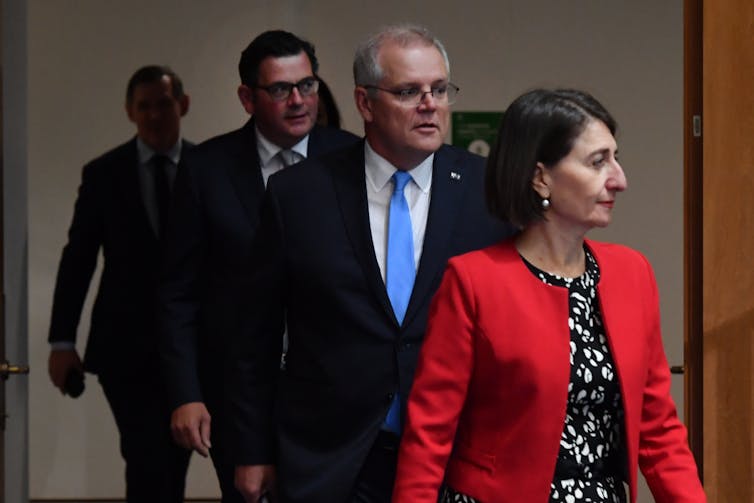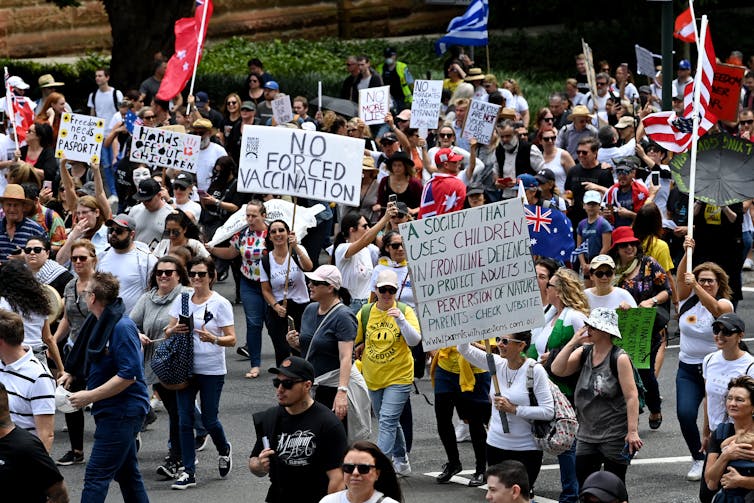Overall, Australian governments managed the first two years of the COVID pandemic well. Border closures and state actions such as lockdowns averted 18,000 deaths in 2020 and 2021.
This came at a cost in terms of separation of families and friends because of border closures, disruption to schooling and economic activity, and individual stress.
The public supported these measures and thought state governments had managed the pandemic well. Support for the Commonwealth government was also high until mid-2021, when the bungled vaccine rollout caused support to plummet.
Now, we are in the grip of a fresh COVID wave. Hospital systems and ambulance services are under severe strain, not just because of an increase in patients, but because the virus has decimated their own workforces. Governments now appear to be much more reluctant to introduce measures to curb its spread, a big difference from the start of the pandemic in 2020.
So, how did it come to this?
Contest of values and rhetoric
Despite the much-vaunted national cabinet, for most of 2020 and 2021 there was no coherent national leadership of COVID-19 response. Then-Prime Minister Scott Morrison and other federal ministers downplayed COVID risks and undermined state public health measures. They attacked lockdowns, state border closures and school shutdowns, while dog-whistling to anti-vaxxers.
This weakened the states’ social licence to pursue effective public health measures.
The differences between the Commonwealth and state governments were in part due to different weighing of the risks of COVID. In 2020 and for the first half of 2021, there was either no vaccine or not enough vaccines, and the prevalent virus strain was quite virulent. As a result, other public health measures were key to controlling the pandemic and minimising hospitalisations and deaths.

But from the middle of 2021, the rhetoric and messaging changed. Led by the Commonwealth government, there was increasing talk of “living with COVID”, reducing restrictions and reopening borders, with the underlying assumption being that, with vaccines, the pandemic was under control. Even the advent of the Omicron wave in late 2021 didn’t lead to a reset, as it was dismissed as “mild”.
There have also been ideological differences throughout the pandemic. Morrison preferred “personal responsibility” to mandates, the latter of which was viewed pejoratively. Individual responsibility is a comfortable position for conservative politicians who tend to minimise the role for government.
In contrast, the very essence of public health is that it is an organised response by society, to quote a standard definition of the field.
Read more: How has COVID affected Australians' health? New report shows where we've failed and done well
The federal electoral context
By early 2022, the effect of undermining the social licence was increasingly prevalent. The public, especially those that who had borne the brunt of the more extensive public health measures, were tired of lockdowns. The evidence about vaccine waning had not yet become apparent, so reliance on vaccines was seen as the appropriate principal public health response. “Living with COVID” was becoming the dominant narrative.
Around the same time, anti-vaxxers had begun to get organised and protested against any public health measures. States sniffed the wind and began to roll back their restrictions.
A Melbourne joke from 2021 went like this:
Question: what is the hardest part of a one-week snap lockdown? Answer: Week five.
The federal Coalition attempted to paint Labor as the party that would reintroduce lockdowns and border closures. The Labor opposition did not want to talk about the pandemic to avoid that bullet.

Post-election politics
This long history is necessary context for the confusion we see today. Despite its defeat at the election, the Morrison government’s pandemic legacy is hindering Australia’s ability to manage the pandemic because of the weakening of the social licence to regulate.
Labelling the more transmissible Omicron variant as mild hasn’t helped, as low average severity coupled with high incidence still leads to overburdened hospitals. The Morrison rhetoric of personal responsibility has proved hard to shift as well. It is certainly seductive – “it is your job to protect yourself and if you don’t, tough luck, you will wear the consequences”.
Of course, that position assumes we are all perfectly rational decision-makers and we bear the full cost of our decisions. Neither is true. We tend to discount future consequences of our decisions, and we are unrealistically optimistic about the chances of getting COVID and its consequences.
Just one person’s infection can have a big impact on others – for example, if they are hospitalised, that impedes access to hospital beds for others – so the cost of poor choices by one person potentially falls on others too.
The public health messaging is also confusing. If I have had only two doses, am I “fully vaccinated”? Does “individual responsibility” involve my lugging a very heavy HEPA filter to ensure clean air in any room I go into? Is the Omicron variant genuinely mild? If so, why do we see all those stories about hospital problems?
And what is the right thing to do about masks? Are cloth masks any good? Or should we all have N95s? And should they then be subsidised? And if masks are “strongly recommended”, why are they not mandated?
It all comes back to the COVID social licence. What proportion of the public will accept a mask mandate? If the public is not convinced of the threat or benefit to themselves and others, compliance will be low. This means public health leaders need to talk up collective responsibility and collective benefit, the antithesis of the individual responsibility mantra. This has been missing from the national response.
Talking up individual responsibility means leaders don’t have to lead or shape collective behaviour. Media hype about regulatory fatigue, a fraught catch-all concept where the evidence is still developing, hasn’t helped either.
Both New South Wales and Victoria face elections in the next 12 months. Neither government wants to be attacked as the government of lockdowns and mandates when the risks of not acting have been downplayed for so long.
Read more: How the pandemic has brought out the worst — and the best — in Australians and their governments
So where to from here?
Public health messaging over the past six months has been woeful. Political leaders are sometimes seen in masks, but mostly not. There has been little messaging about third and fourth doses, and so we have poor third-dose rates, despite what we now know about vaccine waning. The “Omicron is mild” message has led to a “no worries mate” insouciance among the public.
But political and public health leaders must now exercise leadership. Public health requires collective action, not simply a reliance on the easy cop-out of individual responsibility. This will require a carefully planned transition from the discredited positions that have made a public response so much harder now than it was a year ago, and consistent positions across party lines that put the public’s health ahead of cheap political shots.
Leaders need to adopt a more nuanced approach to responding to COVID, jettisoning the simplistic all-or-none dichotomy.
Finally, the mainstream media also need to resile from their knee-jerk rejection of any public health action as akin to lockdowns and economic catastrophe.
The authors do not work for, consult, own shares in or receive funding from any company or organisation that would benefit from this article, and have disclosed no relevant affiliations beyond their academic appointment.
This article was originally published on The Conversation. Read the original article.







